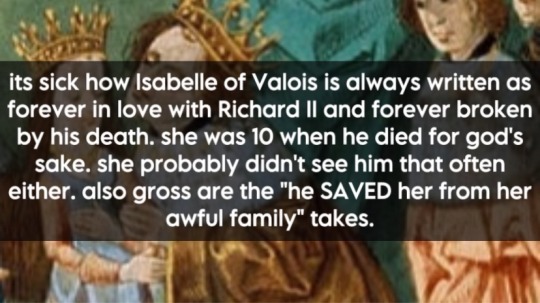#isabella of valois
Explore tagged Tumblr posts
Text
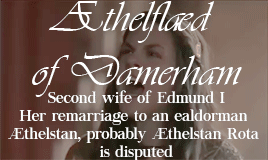

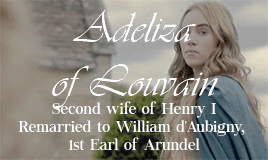

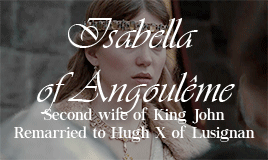



wives of english kings who remarried after their deaths
#history#historyedit#weloveperioddrama#weloveperioddramaedit#catherine parr#katherine parr#catherine of valois#isabella of valois#isabella of angouleme#margaret of france#adeliza of louvain#emma of normandy#aethelflaed of damerham#my gifs#my gifsets
149 notes
·
View notes
Text
Isabelle could get Richard to do the dance from the opening of My Deer Friend Noktotan
2 notes
·
View notes
Text
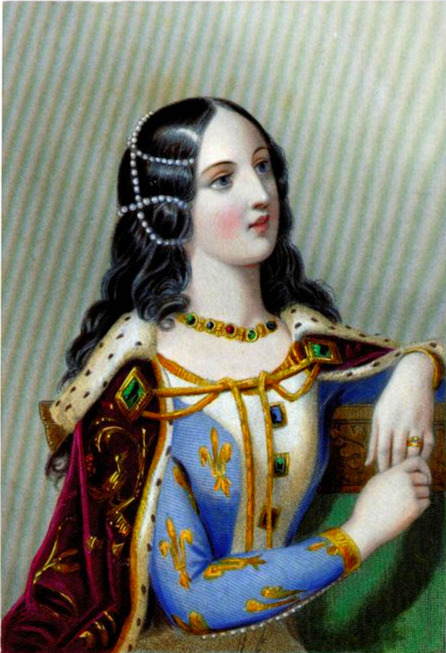
3 notes
·
View notes
Text
ISABELLA OF VALOIS // QUEEN OF ENGLAND
“She was Queen of England as the wife of Richard II, King of England, between 1396 and 1399, and Duchess of Orléans as the wife of Charles, Duke of Orléans, from 1406 until her death in 1409. She had been born a Princess of France as the daughter of King Charles VI and Isabeau of Bavaria. She married Richard at the age of 6, who was 22 years her senior, to ensure peace between their countries. The fact that she was a child was discussed, but King Richard said that each day would rectify that problem; that it was an advantage as he would then be able to shape her in accordance with his ideal; and that he was young enough to wait. In spite of their age difference and the marriage being politically arranged, Isabella and Richard developed a mutually respectful relationship. Due to the age of Isabella (the Canonical law for sexual consummation being twelve), the marriage was never sexually consummated. However, Isabella and Richard enjoyed a good platonic relationship, which has been compared to that between a father and his adopted daughter or between a niece and a doting uncle. He was noted to have treated her not as a wife but rather as the daughter he and his first wife Anne never had. The king regularly visited her in Windsor, where he treated her with respect, entertained her and her ladies-in-waiting with humorous conversation, and pampered her with gifts and toys. Isabella reportedly enjoyed and looked forward to these visits.”


1 note
·
View note
Text


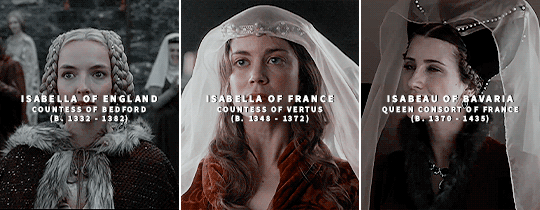
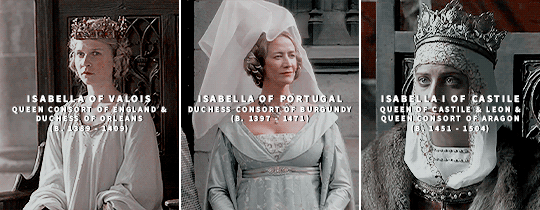

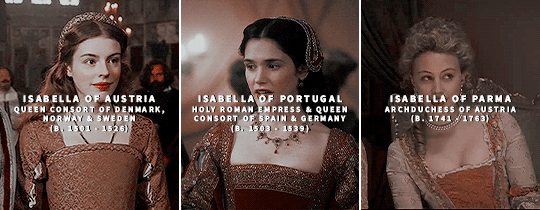
↳ Historical Ladies Name: Isabella/Isabelle
#isabella of gloucester#isabella of angouleme#isabella of england#isabella of aragon#isabella of france#isabella of valois#isabeau of bavaria#isabella of portugal#isabella i of castile#isabel neville#isabella d'este#isabella of austria#isabella of parma#historicalnames*#historyedit#my gifs#creations*
419 notes
·
View notes
Photo
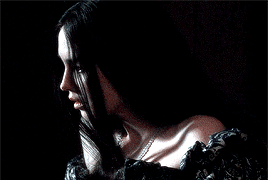
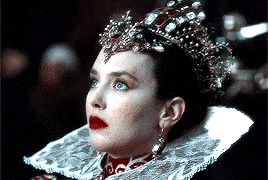
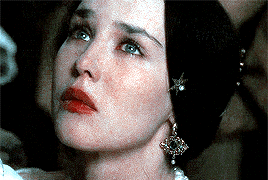


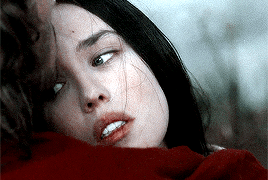
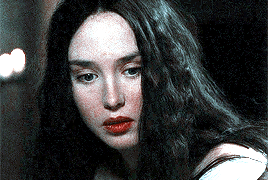
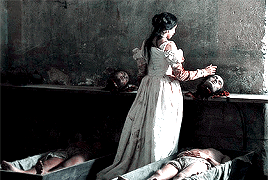
Isabella Adjani as Marguerite de Valois in La Reine Margot (1994)
#la reine margot#la reine margot (1994)#isabella adjani#marguerite de valois#marguerite de navarre#perioddramaedit#period dramas#periodedit#*mine
923 notes
·
View notes
Text

Philip II of Spain, his four wives, and their children who survived to adulthood:
L-R:
Maria Manuela of Portugal with her son Carlos, who she died shortly after giving birth to.
Mary I of England, who experienced a false pregnancy but had no children.
Philip II
Elisabeth of Valois, with her daughters Isabella Clara Eugenia and Catherine Michelle. She also miscarried twin girls, and her youngest daughter died soon after birth.
Anna of Austria with her son, the future Philip III. Three sons: Charles, Ferdinand, and Diego, as well as a daughter named Maria, died in childhood.
#maria manuela of portugal#mary i#philip ii#elisabeth of valois#isabella clara eugenia of spain#catherine michelle of spain#anna of austria#philip iii#long live the queue
22 notes
·
View notes
Text
The pipeline of Charles “they had to deceive and drag me to my wedding” ofthe Bold, to his son in law Maximilian “hey… This Burgundian lady is pretty. I think I’m going to like her :)”, Holy Roman Emperor to Maximilian’s son Philip “marry me to this girl right now, idc if we need more pomp, I need to consummate” the Handsome is real, and it can happen to you too.
#Charles the Bold#Maximilian I#Philip the Handsome#House of Valois#house of habsburg#And then we have Charle’s namesake and great grandson (Charles V) who was so love struck he was faithful to his wife and never got over her#Also the way the consorts got sassier… From Isabelle of Bourbon being merely described pliant and faithful#To Mary of Burgundy being (ahem) THE DUCHESS OF BURGUNDY#To Joanna of Castile refusing to put up with her husband and her father’s bullshit#(And to Isabella of Portugal being a good empress and regent as Charles was away)
3 notes
·
View notes
Text
Happy birthday to Elisabeth of Valois, Queen of Spain, childhood bestie of Mary Stuart, and partroness of my profile pic (Sofonisba Anguissola).
Elisabeth was apparently not a morning person and had a tendency to overspend. Here's to a real one.
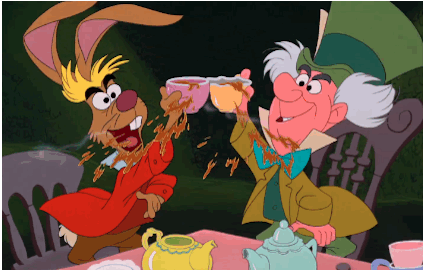
#shes so relatable#elisabeth of valois#early modern history#i think about her every time i nap#philip ii of spain#also mother of the spanish infantas#isabella and catalina
17 notes
·
View notes
Text
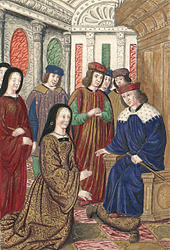
Isabel of Portugal (only daughter of Queen Philippa of England and King João of Portugal), Duchess of Burgundy in an encounter with King Charles VII of France.
#house of avis#house of valois#duchess of burgundy#Isabel of Portugal#Isabella of Portugal#house of lancaster#Philippa of Lancaster#João I of Portugal#Charles VII of France
9 notes
·
View notes
Text
Fantasy Guide to Dowager Queens and Queen Mothers
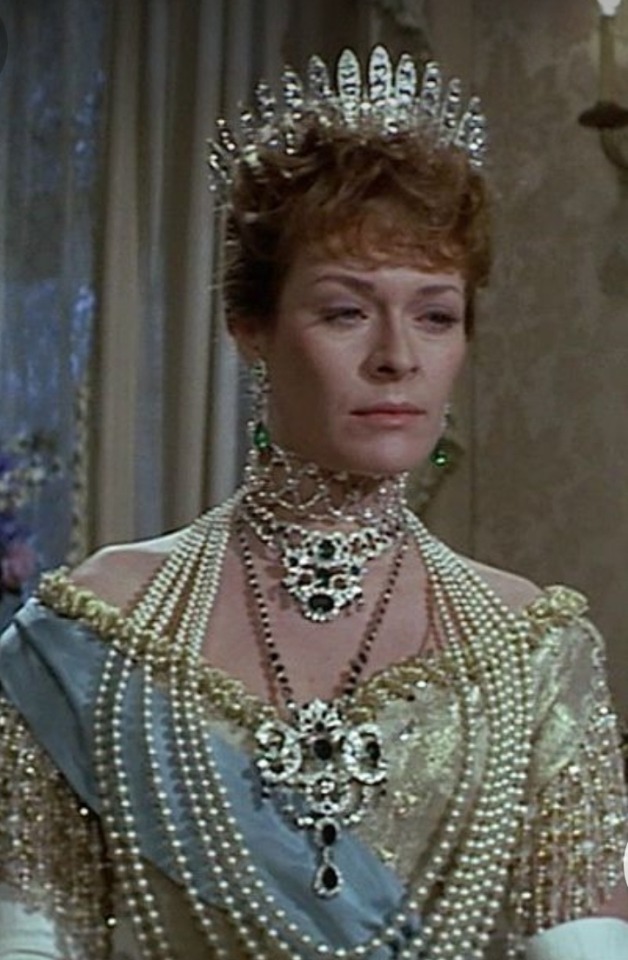
The King is dead. Long live the next monarch (I guess). Their eldest child is now monarch, their other kids have probably started up lives elsewhere or started careers in the military or such. But what happens their Queen?
Queen Mother vs Dowager Queen
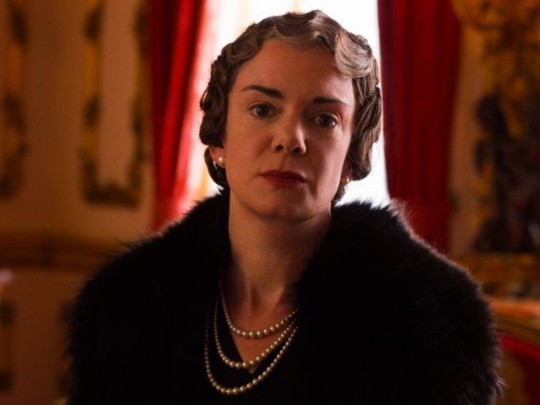
There are two titles the now widowed Queen can take after her husband dies. The first is Dowager Queen or Queen Dowager, which basically means ex-Queen or the previous Queen. The second is Queen Mother, which is the title which can be taken by the mother of the next monarch (this title cannot be granted to step-mothers). Ex-Queens who mothered the current monarch can go for either title if they wish. As for addressing a former Queen, it will still be "Your Majesty" and she would simply be referred to as Queen Firstname.
Life and Perks
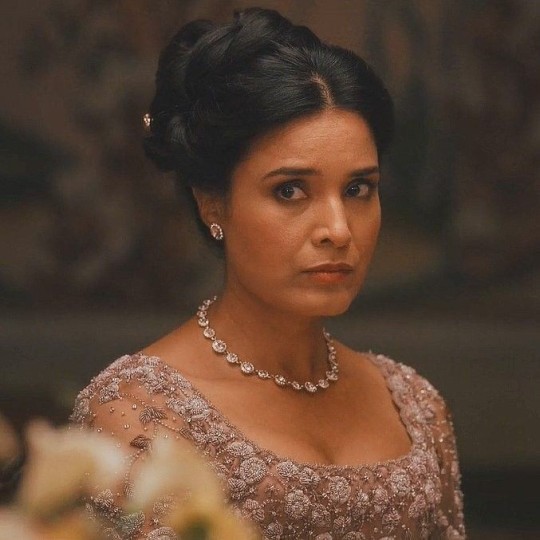
The former Queen will move out of the palace after a few weeks. She will take up residence at one of the Crown's many palaces or houses, able to keep on as many servants as she wants - or that is paid for. She can typically do whatever she likes now, she can travel, she can live at court, she can spend her life away from it all in the country. She will have to surrender her official jewelry which sucks. This can lead to trouble such as the tension between Dowager Empress Maria Feodorovna and Empress Alexandra. Dowager Queens and Queen Mothers usually inherited lands and estates from their husband's will, which basically is a way to support them and their lifestyle. They may also recieve money from the Crown annually. However, some Dowager Queens faced some trouble if the new monarch didn't want to provide for them. This often led to conflict.
Duties

The former Queen might also be called in to help the Crown. She might be sent on diplomatic state visits, act as a diplomatic hostess, advise the new monarch and stand in for them at events if needed. The former Queen will also take an active role in the family if she wishes. Some Dowager Queens and Queen Mothers might act as Regents for underage monarchs.
Prospects

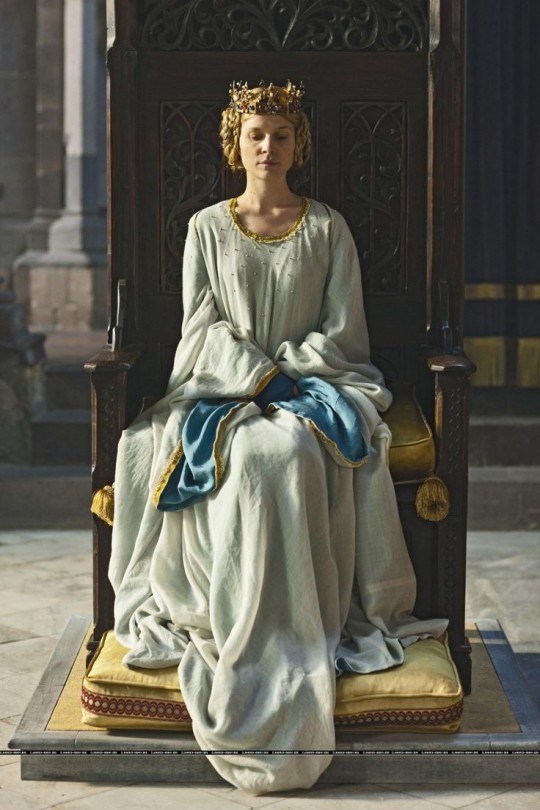
Being a Dowager or the Queen Mother is a relatively cushy job. While you lose some influence and prestige, you are still highly ranked but with less responsibility. Most ex-Queens spend their time relaxing and treating themselves while some stayed relevant with taking on full calenders of duties and events. Mostly, as long as you help out occasionally, live a quiet life, you will pretty much have a nice life. However, there have been instances of Dowager Queens and Queen Mothers going a little off the rails. A Dowager Queen without children might leave behind her new country and go home if she wanted to. She would remain Dowager Queen with all the perks unless she remarried. Some young widowed Queens remarried to varying successes (Catherine of Valois, Isabella of Angoulême, Kathryn Parr, Queen Margaret Tudor, Mary Tudor Queen of France).
#Fantasy Guide to Dowager Queens and Queen Mothers#Queen mothers#Dowager Queens#Fantasy Guide#writing#writeblr#writing resources#writing reference#writer#writer's problems#wtwcommunity#writing reference writing resources#Writing reference writing help#Writing help#writing research#Research#Reference#Writing guide
341 notes
·
View notes
Photo

Joan of Arc
Joan of Arc (Jeanne D'Arc, l. c. 1412-1431 CE) was a medieval peasant who, claiming to receive visions from God, turned the tide of the Hundred Years' War in favor of a French victory. She was famously martyrd for standing by her claim of divine inspiration and later canonized as a saint.
She was born in Domremy, France to a peasant farmer but, at the age of 13, received a revelation while standing in her father's garden that she should lead the French to victory over the English and ensure that Charles, the dauphin (Charles VII of France, r. 1422-1461), was crowned at the traditional site of Rheims.
Joan succeeded in lifting the Siege of Orleans in 1429 and Charles was crowned at Rheims in July of the same year following the Loire Campaign. Joan was captured by the Burgundian allies of the English in 1430 and sold to them. The English could not prosecute a woman who claimed she was serving God but could not allow even the suggestion she was telling the truth because that would mean that God was on the French side of the conflict. They finally convicted her of being a relapsed heretic and burned her at the stake in May 1431.
The trial of Joan of Arc was reviewed as early as 1452, found to be invalid, and Joan was exonerated and proclaimed a martyr in 1456. She was later canonized and is one of the patron saints of France in the modern day.
The Hundred Years' War
The Hundred Years' War (1337-1453) was a conflict between France and England over the legitimate succession to the French throne. William the Conqueror led the Norman conquest of England in 1066, ruling England from 1066-1087 and establishing a French monarchy. The later kings of England still had estates and interests in France and periodically would make some gesture asserting their rights, disregarding the policies or wishes of the French king. The monarchy in France, therefore, wanted to cut England's power in their country while the English worked to increase the power they already had there.
In 1328, Charles IV of France (r. 1322-1328) died, leaving no male heir. Charles' sister, Isabella of France, claimed the French throne for her son, Edward III of England (r. 1327-1377) but her claim was denied because she was a woman and women were not allowed to make such claims. The throne passed to Charles' cousin, Philip VI (r. 1328-1350), and the antagonistic relationship of these two monarchs – Edward and Philip – finally ignited the war in 1337.
The war was not one long continuous conflict but a series of military campaigns, waged mostly on French soil, which consisted of hostilities followed by a truce and then re-engagement. Modern-day scholars have divided the history of the war into three periods for ease of study. Joan of Arc appears in the final period, known as the Lancastrian War (1415-1453) after the House of Lancaster, the ruling house of England at the time.
The Lancastrian War began with the stunning victory by Henry V of England (r. 1413-1422) at Agincourt where he defeated a numerically superior French force. Throughout the Hundred Years' War, English victories far surpassed those of the French and in this last phase of the war, that paradigm seemed it would hold following Agincourt. Henry V married Catherine of Valois, daughter of the sitting French king, Charles VI (r. 1380-1422), under the terms of the Treaty of Troyes (1420) and could now lay claim to the throne of France. Charles VI, however, had a male heir, the dauphin Charles, who maintained his right to the throne and was able to garner support for his claim.
English victories continued as Charles' supporters struggled to drive the English from France and legitimize his rule by crowning him king at Rheims, a city then held by the Burgundian allies of the English. The dauphin Charles only had any power in and around the city of Chinon, and his dwindling forces were defeated every time they took the field. It is during this period that Joan of Arc appears and reverses Charles' – and France's - fortunes.
Continue reading...
95 notes
·
View notes
Text
👑🌹The Queen of Love and Beauty🌹👑
Round 1 (3 of 6)
The Queen of Love and Beauty shall hold the honour of presenting unto the winner of the Tournament his Champion's Coronet.
Vote for the lady who, to you, best exemplifies feminine dignity, grace and loveliness
The six contenders with the most votes will advance.












Row 1 - Lucrezia Borgia [Holliday Grainger], The Borgias (2011-2013) - Giulia Farnese [Lotte Verbeek], The Borgias (2011-2013) - Elizabeth de Burgh [Florence Pugh], Outlaw King (2018)
Row 2 - Contessina de Bardi [Annabel Scholey], Medici (2016-2019) - Elizabeth Woodville [Rebecca Ferguson], The White Queen (2013) - Mary Boleyn [Charity Wakefield], Wolf Hall (2015-2024)
Row 3 - Anne Neville [Phoebe Fox], The Hollow Crown (2012-2016) - Kate Percy [Michelle Dockery], The Hollow Crown (2012-2016) - Margaret of Anjou [Sophie Okonedo], The Hollow Crown (2012-2016)
Row 4 - Eleanore of Aquitane [Katharine Hepburn], The Lion in Winter (1968) - Isabella of Valois [Emma Hamilton], RSC’s Richard II (2013) - Anne Boleyn [Genevieve Bujold], Anne of the Thousand Days (1969)
91 notes
·
View notes
Text
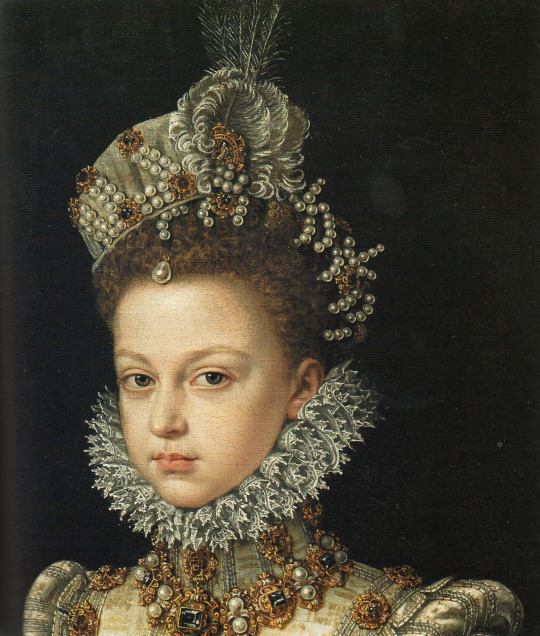
Alonso Sánchez Coello (Spanish, 1531-1588) The Infanta Isabel Clara Eugenia, Detail, 1579 Isabella (1566-1633) was the daughter of Philip II of Spain by his third wife, Elisabeth of Valois. Isabella was around the age of thirteen at the time this was painted. In 1599 she married Albrecht of Austria and took over the regency of the Habsburg Netherlands on behalf of her father. Philip was close to both of his daughters, in particular to Isabella who was not married off young unlike the traditional custom with princesses.
#different quality and colour#art#spanish art#european art#art history#world history#european history#hispanic#classical art#spanish princess#infanta isabel clara eugenia#1500s#fine art#fine arts#europe#european#oil painting#europa#mediterranean#netherlands#spanish netherlands#classic art#female portrait#female#portrait#painting#woman#portrait of a girl#royal#royalty
295 notes
·
View notes
Text
Below the cut I have made a list of each English and British monarch, the age of their mothers at their births, and which number pregnancy they were the result of. Particularly before the early modern era, the perception of Queens and childbearing is quite skewed, which prompted me to make this list. I started with William I as the Anglo-Saxon kings didn’t have enough information for this list.
House of Normandy
William I (b. c.1028)
Son of Herleva (b. c.1003)
First pregnancy.
Approx age 25 at birth.
William II (b. c.1057/60)
Son of Matilda of Flanders (b. c.1031)
Third pregnancy at minimum, although exact birth order is unclear.
Approx age 26/29 at birth.
Henry I (b. c.1068)
Son of Matilda of Flanders (b. c.1031)
Fourth pregnancy at minimum, more likely eighth or ninth, although exact birth order is unclear.
Approx age 37 at birth.
Matilda (b. 7 Feb 1102)
Daughter of Matilda of Scotland (b. c.1080)
First pregnancy, possibly second.
Approx age 22 at birth.
Stephen (b. c.1092/6)
Son of Adela of Normandy (b. c.1067)
Fifth pregnancy, although exact birth order is uncertain.
Approx age 25/29 at birth.
Henry II (b. 5 Mar 1133)
Son of Empress Matilda (b. 7 Feb 1102)
First pregnancy.
Age 31 at birth.
Richard I (b. 8 Sep 1157)
Son of Eleanor of Aquitaine (b. c.1122)
Sixth pregnancy.
Approx age 35 at birth.
John (b. 24 Dec 1166)
Son of Eleanor of Aquitaine (b. c.1122)
Tenth pregnancy.
Approx age 44 at birth.
House of Plantagenet
Henry III (b. 1 Oct 1207)
Son of Isabella of Angoulême (b. c.1186/88)
First pregnancy.
Approx age 19/21 at birth.
Edward I (b. 17 Jun 1239)
Son of Eleanor of Provence (b. c.1223)
First pregnancy.
Age approx 16 at birth.
Edward II (b. 25 Apr 1284)
Son of Eleanor of Castile (b. c.1241)
Sixteenth pregnancy.
Approx age 43 at birth.
Edward III (b. 13 Nov 1312)
Son of Isabella of France (b. c.1295)
First pregnancy.
Approx age 17 at birth.
Richard II (b. 6 Jan 1367)
Son of Joan of Kent (b. 29 Sep 1326/7)
Seventh pregnancy.
Approx age 39/40 at birth.
House of Lancaster
Henry IV (b. c.Apr 1367)
Son of Blanche of Lancaster (b. 25 Mar 1342)
Sixth pregnancy.
Approx age 25 at birth.
Henry V (b. 16 Sep 1386)
Son of Mary de Bohun (b. c.1369/70)
First pregnancy.
Approx age 16/17 at birth.
Henry VI (b. 6 Dec 1421)
Son of Catherine of Valois (b. 27 Oct 1401)
First pregnancy.
Age 20 at birth.
House of York
Edward IV (b. 28 Apr 1442)
Son of Cecily Neville (b. 3 May 1415)
Third pregnancy.
Age 26 at birth.
Edward V (b. 2 Nov 1470)
Son of Elizabeth Woodville (b. c.1437)
Sixth pregnancy.
Approx age 33 at birth.
Richard III (b. 2 Oct 1452)
Son of Cecily Neville (b. 3 May 1415)
Eleventh pregnancy.
Age 37 at birth.
House of Tudor
Henry VII (b. 28 Jan 1457)
Son of Margaret Beaufort (b. 31 May 1443)
First pregnancy.
Age 13 at birth.
Henry VIII (b. 28 Jun 1491)
Son of Elizabeth of York (b. 11 Feb 1466)
Third pregnancy.
Age 25 at birth.
Edward VI (b. 12 Oct 1537)
Son of Jane Seymour (b. c.1509)
First pregnancy.
Approx age 28 at birth.
Jane (b. c.1537)
Daughter of Frances Brandon (b. 16 Jul 1517)
Third pregnancy.
Approx age 20 at birth.
Mary I (b. 18 Feb 1516)
Daughter of Catherine of Aragon (b. 16 Dec 1485)
Fifth pregnancy.
Age 30 at birth.
Elizabeth I (b. 7 Sep 1533)
Daughter of Anne Boleyn (b. c.1501/7)
First pregnancy.
Approx age 26/32 at birth.
House of Stuart
James I (b. 19 Jun 1566)
Son of Mary I of Scotland (b. 8 Dec 1542)
First pregnancy.
Age 23 at birth.
Charles I (b. 19 Nov 1600)
Son of Anne of Denmark (b. 12 Dec 1574)
Fifth pregnancy.
Age 25 at birth.
Charles II (b. 29 May 1630)
Son of Henrietta Maria of France (b. 25 Nov 1609)
Second pregnancy.
Age 20 at birth.
James II (14 Oct 1633)
Son of Henrietta Maria of France (b. 25 Nov 1609)
Fourth pregnancy.
Age 23 at birth.
William III (b. 4 Nov 1650)
Son of Mary, Princess Royal (b. 4 Nov 1631)
Second pregnancy.
Age 19 at birth.
Mary II (b. 30 Apr 1662)
Daughter of Anne Hyde (b. 12 Mar 1637)
Second pregnancy.
Age 25 at birth.
Anne (b. 6 Feb 1665)
Daughter of Anne Hyde (b. 12 Mar 1637)
Fourth pregnancy.
Age 27 at birth.
House of Hanover
George I (b. 28 May 1660)
Son of Sophia of the Palatinate (b. 14 Oct 1630)
First pregnancy.
Age 30 at birth.
George II (b. 9 Nov 1683)
Son of Sophia Dorothea of Celle (b. 15 Sep 1666)
First pregnancy.
Age 17 at birth.
George III (b. 4 Jun 1738)
Son of Augusta of Saxe-Gotha (b. 30 Nov 1719)
Second pregnancy.
Age 18 at birth.
George IV (b. 12 Aug 1762)
Son of Charlotte of Mecklenburg-Strelitz (b. 19 May 1744)
First pregnancy.
Age 18 at birth.
William IV (b. 21 Aug 1765)
Son of Charlotte of Mecklenburg-Strelitz (b. 19 May 1744)
Third pregnancy.
Age 21 at birth.
Victoria (b. 24 May 1819)
Daughter of Victoria of Saxe-Coburg-Saafield (b. 17 Aug 1786)
Third pregnancy.
Age 32 at birth.
Edward VII (b. 9 Nov 1841)
Daughter of Victoria of the United Kingdom (b. 24 May 1819)
Second pregnancy.
Age 22 at birth.
House of Windsor
George V (b. 3 Jun 1865)
Son of Alexandra of Denmark (b. 1 Dec 1844)
Second pregnancy.
Age 20 at birth.
Edward VIII (b. 23 Jun 1894)
Son of Mary of Teck (b. 26 May 1867)
First pregnancy.
Age 27 at birth.
George VI (b. 14 Dec 1895)
Son of Mary of Teck (b. 26 May 1867)
Second pregnancy.
Age 28 at birth.
Elizabeth II (b. 21 Apr 1926)
Daughter of Elizabeth Bowes-Lyon (b. 4 Aug 1900)
First pregnancy.
Age 25 at birth.
Charles III (b. 14 Nov 1948)
Son of Elizabeth II of the United Kingdom (b. 21 Apr 1926)
First pregnancy.
Age 22 at birth.
379 notes
·
View notes
